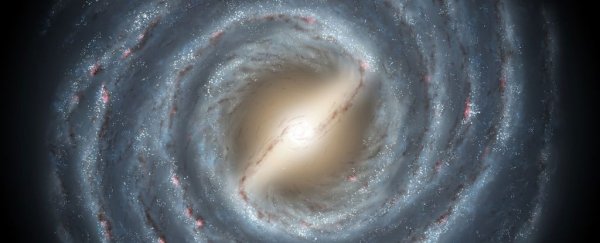If you're the kind of person who worries about how accurate (or perhaps not) your creaky bathroom scales might be, spare a thought for astrophysicist Gwendolyn Eadie. It's her job – or, rather, area of study – to figure out the mass of the whole galaxy.
No easy gig, to be sure, but according to Eadie's latest estimates, we now have a new measurement for the mass of the Milky Way, and it's a biggie. She calculates that the Milky Way has a mass equal to 7 x 1011 solar masses. To put it another way, the galaxy has the same mass as 700 billion Suns. "And our galaxy isn't even the biggest galaxy," Eadie says.
To drill down a little further, the Sun has about 330,000 times the mass of Earth, or 2 nonillion kilograms (that's a 2 followed by 30 zeroes).
Yep, these are some pretty crazy numbers, but astronomical mass estimations like this are an important part of figuring out how the Milky Way came to be – and where it's headed.
"Understanding our galaxy's mass puts it into a better cosmological context," Eadie, a PhD student from McMaster University in Canada, told Michelle Z. Donahue at National Geographic. "People who study the evolution of galaxies look at how the mass relates to its evolution. If we have a better handle on what the mass of the Milky Way is, we can understand how it and other galaxies form and evolve."
There's a lot to take stock of in these kinds of calculations. The mass of a galaxy includes all its stars, planets, and moons, plus gases, dust, and other cosmic material. And that's just the visible matter – let's not forget dark matter, something we still know very little about, but which scientists think exerts a gravitational force on all the non- dark matter around it.
To make matters worse, getting a handle on the visible objects we can actually see is complicated by the fact that we're located amidst all the matter we're trying to measure.
"The fact that we sit inside the galaxy does introduce some difficulties," Eadie told Tim Radford at The Guardian. "We have a heliocentric perspective: we see everything from the perspective of our Sun's position (and movement) through the galaxy. It's important that we take the movement and position of the Sun into account when we measure the motions and positions of other objects in the Milky Way."
Together with fellow researcher and supervisor William Harris, Eadie devised a new way for calculating the movement and velocity of globular clusters – spherical groups of stars that act like satellites, orbiting the galactic core.
The new technique, which helps fill in the gaps on what we don't know about some globular cluster velocities, provides what the researchers think is the most accurate estimation yet of the total galactic mass. Prior to the 700 billion Suns calculation, estimates varied between the mass of 100 billion Suns to 1 trillion.
"We can also compare the total mass estimate to the amount of visible matter that we see in the Milky Way and then get a prediction for the amount of dark matter," Eadie told The Guardian. "With our estimate, it seems that dark matter makes up about 88 percent of the Milky Way's mass."
The findings were presented at the annual meeting of the Canadian Astronomical Society this week and have been submitted to The Astrophysical Journal.
The research hasn't been accepted for publication yet, so we'll have to wait for it to be peer-reviewed before we can start adding it to textbooks and the like, but it's already drawing praise from some within the astrophysics community.
"Figuring out how fast, and in what direction, globular clusters are moving is pretty hard. Combining all of these data together in a consistent model for the Milky Way is a real challenge," Alan McConnachie from Canada's Herzberg Institute for Astrophysics, who wasn't involved with the study, told National Geographic. "This work is a big step toward being able to claim with confidence that we know how massive our home actually is."
